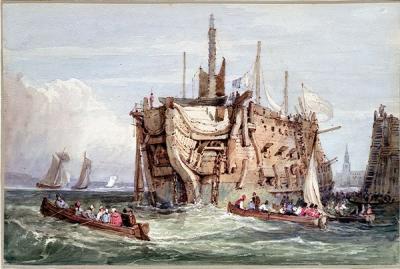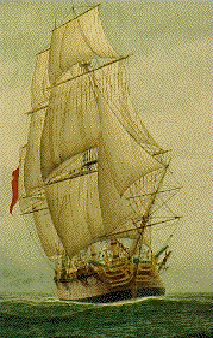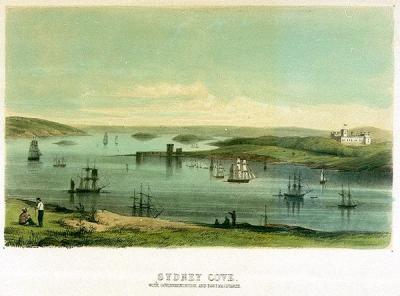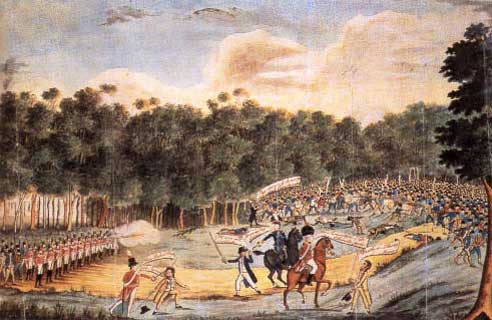Irish-Australia Flag – featuring the Southern Cross & Harp
IRISH AUSTRALIA
by
Merle O’Donnell
Australia was such a quiet place up to the late eighteen-thirties with nothing breaking the calm way of life of the settlers except native uprisings and massacres, flood, fire, rebellion, famine and similar minor disturbances. Then suddenly large numbers of Irish arrived and from then on things became a little more lively, bedad…
In modern day Australia a cursory look in any telephone directory will reveal a large number of Irish surnames, particularly in the states of New South Wales and Queensland (which, until 16th June, 1859, was part of NSW). At least one out of every three Australians is Irish born or of Irish heritage, making the total number somewhere between 7 and 8 million people. More than the population of Ireland. So, how did this come about and what brought them here?
In the beginning it was transportation, the banishment of convicts to a place called Botany Bay in the Colony of New South Wales. They came on the first ships as convicts, marines (to guard them) with their wives and families, seamen, surgeons and surgeon’s assistants. Most were convicts sentenced in England for petty crimes. They were unremarked as Irish, a muted facet of the British imperial and colonial enterprise and except for their names recorded on the ships’ registers, little is known of them. Unwilling emigrants, they sailed in what is known as the First Fleet on a nightmare journey to a distant land, and helped pioneer a nation.
In 1786 Britain’s gaols were overcrowded with petty criminals. The American War of Independence meant the loss of that country as a dumping ground so apart from the already overcrowded prison ships (hulks) anchored off the Thames and the Royal Arsenal Docks at Woolwich, the unfortunate prisoners had nowhere to go.

Prison Hulk. National Maritime Museum. London.
And so, the following year, in desperation, the British government took up Sir Joseph Bank’s suggestion that Botany Bay would be a good spot for a penal settlement. The notion of founding a colony of convicts was greeted with mockery and prompted many street ballads and at least one comic opera. The dour Scottish navigator Dalrymple declared the scheme absurd and hardly calculated to discourage crime, “for all that would happen to them is that they will be sent at the Public Expense, to a good country and temperate climate where they will be their own masters.” Still, the government stood firm and went in search for someone to run the place. Captain Arthur Phillip, RN, an obscure naval officer on half-pay and farming in Kent was given a commission as Governor-in-Chief of the new settlement. As Phillip adjusted to his new status the government hired nine ships and set about provisioning them together with two naval vessels and three supply ships with enough food (it was estimated) to sustain them for two years, by which time the colony should have became self-sufficient.
In January, 1787, the transport ship Alexander received the first of its convicts from the hulk Dunkirk. A few days later, all the female convicts of Newgate under sentence of transportation were taken by heavy wagons to Gravesend to embark on the 330 ton ship Lady Penhryn. Over the next three months the remaining four transport ships, Charlotte, Friendship, Prince of Wales and Scarborough, received their compliment of human cargo. Finally, on the morning of Sunday the 13th of May,1787, the First Fleet comprising the six convict transports and HMS Sirius, HMS Supply, Fishburn, Borrowdale and Golden Grove raised anchor in Portsmouth and sailed into the Channel for the perilous voyage to Botany Bay. The Fleet carried a total of 1,420 people – 15 officials and passengers, 323 ships’ crews, 247 marines, 46 marines’ wives and children and 775 convicts of whom 193 were women with 14 infants and children. Over half the convict women were domestic servants by trade and none had been convicted for prostitution. The vast majority of men and women had committed petty theft.
Of those aboard this First Fleet, convicts, crew, Military officers and guards, were 141 persons know to be Irish born. To name a few:
John Kennedy, Thomas O’Brien, Mortimore Lynch, Robert Ryan were privates in the Marines. John Walsh was a seaman. Dennis Considen, born Ireland was surgeon on Scarborough. Thomas Jamison Co. Down, was a surgeon’s mate on HMS Sirius. Mary Kennedy was listed as a mariner’s wife. John Ryan, 23, was a convict sentenced at the Old Bailey for stealing clothing to the value of thirteen shillings; Redmond McGrath, 30, was sentenced at the Old Bailey for stealing household goods to the value of thirty shillings. McGrath who had been involved in the Mercury Mutiny, died in New South Wales in 1788, and was described on his death as “Edmund McGrass, papist”; William McNamara, 24, sentenced at the Old Bailey for stealing clothing to the value of twenty shillings, listed his occupation as Seaman A report from the hulk Dunkirk where he was imprisoned describes him as “a dangerous fellow, low in cunning and a Catholic”. Francis Carty convicted of highway robbery, disappeared aged 31 during the voyage, may have fallen overboard. Patrick Delaney, 25 convicted of assault and highway robbery of 147 shillings died during the voyage. Jerimiah Hurley, 23, convicted of stealing clothing to the value of seventy-six shillings survived the voyage but received brutal treatment in the new colony.
|

|

|

|
|
Alexander
|
Lady Penhryn
|
Charlotte
|
The 15,000 mile voyage of the First Fleet to New South Wales via Teneriffe, Rio de Janiero and Capetown, took over 8 months. Captain Phillip reported that there were only 23 deaths on the voyage, 46 were either discharged or deserted. 22 births were recorded.
Botany Bay lacked a sheltering harbour, fresh water and soil for growing crops, and was quickly deemed unsuitable for a settlement. Instead, a quiet cove nine miles north inside Port Jackson was chosen and named Sydney Cove (now the CBD of the City of Sydney). The convicts on seeing the fine blue bays of the cove, its glistening headlands, raised a cheer of joy. The native inhabitants (Aboriginals) with white clay markings on their faces brandished their spears and shouted “Warra”, Warra,” (go away!) No-one noticed.
On the 26th of January the First Fleeters went ashore. The Aboriginals watched on from a safe distance, perhaps vaguely aware of the beginning of an era that would catastrophically affect their lives. Phillip gave strict orders they should not be offended or molested on any account. At dusk he and his officers assembled around a crude flagstaff on the shore and while the Marine detachment fired volleys from their muskets, Phillip formally took possession of the country. Thus began the first day in the life of modern Australia.

The First Fleet entering Sydney Cove, January, 1788
Drawings from a voyage to New South Wales, William Bradley. Dec 1786 – May 1792
Over the next few days the cove rang with the echo of axes as a hundred convicts from the Scarborough cleared the bush and felled the trees on the shores of the Cove and along the headlands. The days were hot and humid, the work frequently delayed by midsummer rainstorms. On January 6th, in a fever of excitement the women convicts were landed on shore - let loose might be a more accurate description. At 6pm the disembarkation was complete. Within the hour, before all the tents could be pitched and everything was in order to receive them, a violent thunderstorm rolled in and drenched them to the skin. The marines requested – and were given by the officers ‘rum to make merry with the women’ while the convict men sneaked through the bush to the women’s tents. The night quickly deteriorated into an orgy of drinking, brawling, nakedness and debauchery under the half-collusion, half-condemnation of those in charge.
From the start the new settlement was beset with problems. Poor health from long imprisonment followed by the rigors of the voyage, meagre rations and lack of prevention against scurvy took its toll on the convicts. Many died shortly after arriving. Many more were left in a fragile state of health. Food was a major problem. Few convicts knew how to farm. The climate was hot and dry, few of the crops they planted germinated. Though there was plenty of fish in the bay they were poor fishermen. Before they knew it, everyone was on rationed food.
The little settlement struggled to survive, exposed to attacks by the Aboriginals and foreign powers lurking off the coast. The marines were in the habit of getting drunk and not guarding the convicts properly. For more than two years, no ship from England reached Sydney Cove and a terrible sense of hopelessness and isolation settled over the place. Famine and scurvy began to take their toll. In 1790, half the Marines and 200 convicts were sent to Norfolk Island to ease the food shortage. HMS Sirius was ordered to China to bring back supplies. Her wreck on Norfolk Island plunged the settlement into a deep depression. Military volunteers organised a roster and went fishing every second night. Phillip ordered the half rations to be reduced further, while HMS Supply set sail for Batavia in the hope that the Dutch would help the situation. Surgeon White wrote to a friend in London, “should any accident happen to it (Supply) Lord, have mercy on us.”
Finally, on the evening of 3rd of June, 1790 a flag was hoisted at South Head, the signal of an incoming ship. Beating up the harbour was the Lady Juliana, later to be known as “the floating brothel.” Three days later the wind had abated sufficiently for the Lady Juliana to be towed up river to Sydney Cove. Among the sad huts and the rocks of the water’s edge hungry men and women stood in the pouring rain and watched her warp in. The settlement had been expecting a store ship stocked with food, and with skilled men aboard to take charge of the building and agricultural projects. What it got was 222 females and their brats to be housed and fed. What rations were brought hardly made a difference.
Two weeks later the store ship Justinian sailed in, tipping the balance from probable starvation to probable survival.
The Second Fleet arrived at the end of the month and began to disembark its human cargo. Amidst all the cheerful activity on shore, joy turned to disbelief and horror to those who watched. The Sydney Cove Chronicle, 30th June, 1790 reported: “Diabolical Condition of the Convicts Thereon. 278 died on the fearsome Journey to Sydney Cove. As they came on shore people were hardly able to to move hand or foot. Such as could not carry themselves upon their legs crawled on all fours. Those who through their afflictions were not able to move, were thrown over the side of the ships as sacks of flour would be thrown into small the boats; some expired in the boats, others as they reached the shore….More had not the opportunity ever to leave their ocean prisons for as they came upon the decks, the fresh air only hastened their demise. A sight most outrageous to our eyes were the marks of leg irons upon the convicts, some so deep that one could see the bones…”
The Second Fleet ships were contracted to a firm of former slaving contractors, Camden, King and Calvert, who undertook to transport the convicts for a flat fee of 17 pounds 7 shillings per head, whether they survived the voyage or not. Upon the fleet’s return to England, charges were laid against the ships’ masters and their surgeons, but not one person stood trial.
The first convict transport ship to sail direct from Ireland to Australia was the 400 ton Queen, which sailed from Cork harbour at the beginning of April 1791 and joined the Third Fleet (once again contracted to Camden, King and Clavert), bound for the Colony of New South Wales. On board the Queen were 157 Irish convicts comprising 133 males, 22 females and 3 children –
Margaret, daughter of Sarah Brennan age 2 weeks, Judy, daughter of Mary Connor age 9 months, and John, son of Catherine Edwards, age 2 years.
It was a hard and callous age, when even children were convicted and transported. The youngest convict on the Queen was an 11 year old lad from Dublin, David Fay (Fahey?). David was convicted at the Assizes in 1790 (crime unknown) and sentenced to seven years transportation. Accompanying him was 12 year old James Blake, also from Dublin. Convicted of stealing a pair of silver buckles he was sentenced to seven years transportation. Within four months of his arrival in Port Jackson, young James Blake was dead. Research to date has failed to uncover the fate of David Fay. The oldest convict on board the Queen was Patrick Fitzgerald, aged 64. Fitzgerald , a Yeoman from Dublin was found guilty of stealing clothes and sentenced to seven years transportation.
Prisoners on convict transports were invariably subjected to brutal treatment and corruption was widespread, particularly in the early days when contractors sought as much profit from a voyage as possible. The cost of transporting and individual from Dublin was 17 pounds plus rations for the passage and the maintenance of each convict for one year in the Colony. Upon embarkation of the Queen seven convicts were found to have died during the voyage and the rest were in such poor and emaciated physical condition that a magisterial enquiry was ordered. It was soon discovered that the food contracted for had been illegally short-rationed. Again, no charges were laid against the English contractors, Messrs. Camden, Calvert & King, but this was their last assignment due to the litany of complaints brought against them by the prisoners.
With the growth of the New South Wales settlement increasingly large numbers of free settlers arrived from England. The first free
Irish settlers arrived in 1793, but their numbers were few.

Sydney Cove and Government House 1800
Transportation from Ireland direct to Australia for crimes committed in Ireland continued. In the early 1800’s large numbers of political prisoners began to pour in. Irish rebels were considered a particular threat by the Colonial authorities and were treated more harshly than the rest. On the 4th of March, 1804, marshall law was proclaimed for the first time on Australian soil when the Irish convicts broke out of Castle Hill prison farm north-west of Sydney Town, to take on the British Redcoats. The revolt, called The Battle of Vinegar Hill, was quickly and bloodily crushed.

5 March, 1804. The Battle of Vinegar Hill. Nat. Lib. Of Australia
On the 5th of February, 1806 the ship Tellichery sailed into Port Jackson bringing the last remnants of the 1798 rebellion and Robert Emmet’s 1803 Rebellion. Amongst them was one of the first Gallaghers to be transported, namely Christopher Gallagher from Co. Kildare, and five State Prisoners, Michael Dwyer, John Mernagh, Arthur Devlin, Hugh Vesty Byrne and Martin Burke – all from Wicklow. Thousands of miles from Ireland a number of the Tellichery men took part in a rebellion known as The Battle of Vinegar Hill.
For the first thirty years the little Colony struggled to survive. Convicts were put to work under the harshest conditions to work on roads and prison farms and to erect public buildings and homes for the government officials and the growing number of free settlers. On the 24th of December, 1849, the convict ship Adelaide weighed anchor in Port Jackson. The 259 male prisoners who disembarked were the last that Colony would receive. The British Government had ordered an end to the transportation of convicts to New South Wales, but continued to send them to Van Diemen’s Land (Tasmania) and the Swan River Colony in Western Australia.
The years 1848 – 50 saw an influx of survivors of the Great Famine. Among them, 4,100 “orphan” girls and young women sent to Australia from the work houses of Ireland under the Earl Grey Scheme. These unfortunate girls faced prejudice and hostility from the large Anglo population before being hired out as domestic servants. This was the future that awaited the many thousands of other single Irish women who emigrated under schemes of assisted passage in the years that followed.
Between 1830 – 1850 many Irishmen and women sailed to Australia as free assisted migrants. The discovery of gold in Victoria in 1851 brought an even larger influx as thousands arrived to try their luck at Ballarat. By 1853 there were several small settlements on the diggings. Among them, the Eureka, which was predominantly Irish. One of the Eureka Irishmen was Peter Lalor, brother of Fintan Lalor, intellectual leader of the short Irish revolt of 1848. On Sunday, 2nd of December, 1854, the diggers led by Peter Lalor, rebelled against the exhoritant cost of miners’ licenses. The violent confrontation, the first and only battle in Australian history between free men and the armed forces of the Crown, was over in in minutes. Twenty-four ill-armed diggers lay dead, another twenty or more were wounded, including Lalor who was hidden by a priest. The trial that followed became a farce and the sentences were lenient. The general feeling was the government was rotten, not the people. The hated license tax was abolished and the miners’ rebellion at the Eureka stockade, entered the pages of folklore.
On the 30th of August, 1853, the last convict ship to sail from Ireland to Australia, the Phoebe Dunbar, left Kingstown (now Dun Laoghaire) bound for Perth, Western Australia, bringing to an end 63 years of transportation between the two countries. During that time, 30,000 Irishmen and 9,000 Irishwomen were sent here as convicts for a minimum of seven years.
From 1858 – 1864, the Donegal Relief Fund, founded in Sydney by Catholic clergyman Archdeacon John McEnroe, boosted the number of Irish immigrants to New South Wales. Among them, the Derryveagh evictees. In the 30 years 1860 – 1890, the flood became a tidal wave.
The sentence of transporation was abolished in 1857 but continued from England until 1868. By the end of 1867, the number of free settlers had grown to such a degree that there was a serious shortage of labourers. In response to requests from Perth, one last ship was despatched. On the 9th of January, 1868, the 875 ton Hougoumont arrived at Fremantle. On board were 108 passengers and 279 convicts including sixty-three Irish Fenians. These men had been convicted of treason in Ireland but imprisoned in England. Among them was John Boyle O’Rielly who, two years later would make a dramatic escape from a road gang in Bunbury, south of Perth, triggering one of the most dramatic episodes in Australian Colonial History, the Catalpa Rescue.
The Irish Australian pioneering immigrants came under a variety of circumstances and imposed on the established order a heavy dose of anti-authoritarianism, Catholicism, clannism and folklore. Hundreds were unrepentant seditionists filled with savage memories and unsettled scores. When the first generation died their colonial born sons and daughters, framed in a similar mould, contributed their share to the national character. Among them the bushranger, Ned Kelly(1855 – 80) who to this day is considered a national icon.
From the 1950s onwards, the percentage of Irish born entering this country increased to substantial numbers. Today there is no aspect of Australian life in which they or their descendents are not represented. Truly, Ireland's loss is Australia's gain.
I am old Botany Bay, stiff in the joints, little to say
I am he who paved the way that you may walk with ease today
I was the conscript sent to hell, to make a desert a living well
I bore the heat, blazed the track, furrowed and bloody upon my back
I split the rock
I felled the tree
The Nation was, because of me.
Dame Mary Gilmour
Sydney Cove today – Sydney Harbour